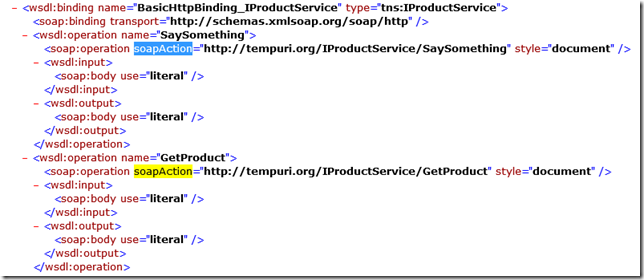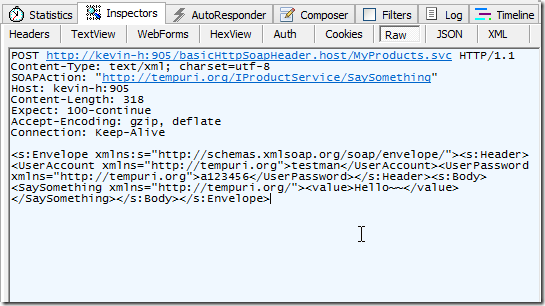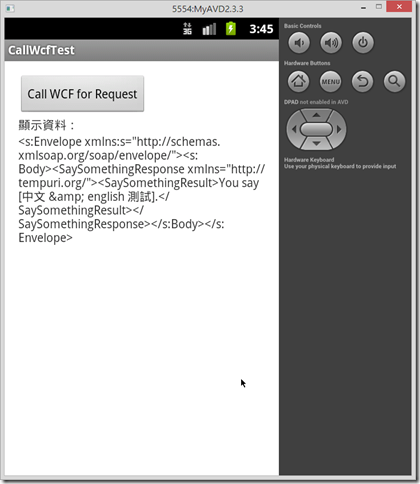WCF安全性認證:SoapHeader(二)使用HTTP Request呼叫
在前面第一篇介紹的WinFrom Client 端程式為了送出request時要產生SoapHeader﹐而另外撰寫了一個ClientHeader類別庫﹐並且必須在組態加入對應的設定﹐手續看起來有些複雜。實務上﹐有時會希望是以WebRequest的原生方式自行組合Soap 格式資料來進行資料的交換。
在開始之前需要先知道一些資料的規則﹐首先由wsdl規格中可以找到SOAPAction。

前面的介紹過程中在使用Fiddler觀察資料時﹐可以看到送出的標準Soap資料格式﹐這是現在在程式中要自行組合的字串﹐其中包含了SoapHeader﹐要呼叫的方法與傳遞的參數。

<soapenv:Envelope xmlns:soapenv=\"http://schemas.xmlsoap.org/soap/envelope/\" xmlns:tem=\"http://tempuri.org/\">
<soapenv:Header>
<UserAccount xmlns=\"http://tempuri.org\">帳號</UserAccount>
<UserPassword xmlns=\"http://tempuri.org\">密碼</UserPassword>
</soapenv:Header>
<soapenv:Body>
<tem:SaySomething>
<tem:value>test</tem:value>
</tem:SaySomething>
</soapenv:Body>
</soapenv:Envelope>有了SoapAction和Soap資料的格式﹐接下來就使用三種平台的方式來撰寫。
1. .Net 的呼叫方式
string wsdlUri = "http://kevin-h:905/basicHttpSoapHeader.host/MyProducts.svc?singleWsdl";
string username = System.Configuration.ConfigurationManager.AppSettings["username"].ToString();
string pwd = System.Configuration.ConfigurationManager.AppSettings["pwd"].ToString();
private void btnCallSaySomething_Click(object sender, EventArgs e) {
try {
HttpWebRequest webRequest = (HttpWebRequest)WebRequest.Create(wsdlUri);
webRequest.Method = "POST";
webRequest.ContentType = "text/xml;charset=UTF-8";
webRequest.Headers.Add("SOAPAction:\"http://tempuri.org/IProductService/SaySomething\""); //<--SOAPAction 別忘了
StringBuilder soapStr = new StringBuilder(Environment.NewLine);
soapStr.Append("<soapenv:Envelope xmlns:soapenv=\"http://schemas.xmlsoap.org/soap/envelope/\" xmlns:tem=\"http://tempuri.org/\">" + Environment.NewLine);
soapStr.Append(" <soapenv:Header>" + Environment.NewLine);
soapStr.Append(" <UserAccount xmlns=\"http://tempuri.org\">"+username+"</UserAccount>" + Environment.NewLine);
soapStr.Append(" <UserPassword xmlns=\"http://tempuri.org\">"+pwd+"</UserPassword>" + Environment.NewLine);
soapStr.Append(" </soapenv:Header>" + Environment.NewLine);
soapStr.Append(" <soapenv:Body>" + Environment.NewLine);
soapStr.Append(" <tem:SaySomething>" + Environment.NewLine);
soapStr.Append(" <tem:value>test</tem:value>" + Environment.NewLine);
soapStr.Append(" </tem:SaySomething>" + Environment.NewLine);
soapStr.Append(" </soapenv:Body>" + Environment.NewLine);
soapStr.Append("</soapenv:Envelope>" + Environment.NewLine);
byte[] buffer = Encoding.UTF8.GetBytes(soapStr.ToString());
webRequest.ContentLength = buffer.Length;
Stream post = webRequest.GetRequestStream();
post.Write(buffer, 0, buffer.Length);
post.Close();
HttpWebResponse response;
response = (HttpWebResponse)webRequest.GetResponse();
Stream respostData = response.GetResponseStream();
StreamReader sr = new StreamReader(respostData);
string strResponseXml = sr.ReadToEnd();
txtOutputValue.Text = strResponseXml;
} catch (Exception er) {
if (er.InnerException != null) {
txtSaySomethingMsg.Text = "InnerException:" + er.InnerException.Message;
} else {
txtSaySomethingMsg.Text = "Exception:" + er.Message;
}
}
}上述的程式執行之後所得到的結果為以下的XML格式資料﹐只要Parse這個資料就可以得到想要的東西。
<s:Envelope xmlns:s="http://schemas.xmlsoap.org/soap/envelope/">
<s:Body>
<SaySomethingResponse xmlns="http://tempuri.org/">
<SaySomethingResult>You say [test].</SaySomethingResult>
</SaySomethingResponse>
</s:Body>
</s:Envelope>2. Java 的呼叫方式
package wcf.com;
import java.io.BufferedReader;
import java.io.ByteArrayOutputStream;
import java.io.InputStreamReader;
import java.io.OutputStream;
import java.net.HttpURLConnection;
import java.net.URL;
import java.net.URLConnection;
public class wcfClient {
public static void main(String[] args) {
String responseString = "";
String outputString = "";
String wsURL = "http://kevin-h:905/basicHttpSoapHeader.host/MyProducts.svc?wsdl";
try{
URL url = new URL(wsURL);
URLConnection connection = url.openConnection();
HttpURLConnection httpConn = (HttpURLConnection)connection;
ByteArrayOutputStream bout = new ByteArrayOutputStream();
StringBuilder xmlInput=new StringBuilder();
xmlInput.append("<soapenv:Envelope xmlns:soapenv=\"http://schemas.xmlsoap.org/soap/envelope/\" xmlns:tem=\"http://tempuri.org/\">\n");
xmlInput.append(" <soapenv:Header>\n");
xmlInput.append(" <UserAccount xmlns=\"http://tempuri.org\">testman</UserAccount>\n");
xmlInput.append(" <UserPassword xmlns=\"http://tempuri.org\">a123456</UserPassword>\n");
xmlInput.append(" </soapenv:Header>\n");
xmlInput.append(" <soapenv:Body>\n");
xmlInput.append(" <tem:SaySomething>\n");
xmlInput.append(" <tem:value>中文字測試</tem:value>\n");
xmlInput.append(" </tem:SaySomething>\n");
xmlInput.append(" </soapenv:Body>\n");
xmlInput.append("</soapenv:Envelope>\n");
byte[] buffer=new String(xmlInput).getBytes();
bout.write(buffer);
byte[] b = bout.toByteArray();
String SOAPAction ="http://tempuri.org/IProductService/SaySomething";
//設定適當的Http參數
httpConn.setRequestProperty("Content-Length",String.valueOf(b.length));
httpConn.setRequestProperty("Content-Type", "text/xml; charset=utf-8");
httpConn.setRequestProperty("SOAPAction", SOAPAction);
httpConn.setRequestMethod("POST");
httpConn.setDoOutput(true);
httpConn.setDoInput(true);
OutputStream out = httpConn.getOutputStream();
out.write(b);
out.close();
InputStreamReader isr = new InputStreamReader(httpConn.getInputStream());
BufferedReader in = new BufferedReader(isr);
while ((responseString = in.readLine()) != null) {
outputString = outputString + responseString;
}
System.out.println(outputString);
}catch(Exception er){
er.printStackTrace();
}
}
}執行後可以看到輸出的結果和前面.Net得到的結果相同﹐接下就要自行parse XML了。
Ps.在使用eclipse撰寫時﹐送出request並能正確的接回資料﹐但後來在傳遞的值改為中文後就一直失敗。直覺是編碼出了問題﹐查了許久才發現﹐eclipse在windows時檔案存檔時預設檔案格式編碼為MS950﹐如果將檔案改存為UTF-8則傳遞中文的問題就解決了。
3. Android 的呼叫方式
時下最流行的行動裝置﹐當然也必須要能呼叫WCF才行﹐以下的示範是以Android 4.2.2版本為例。
在Android 3.0之後在主執行緒上不能直接進行網路活動﹐否則將會得到NetworkOnMainThreadException錯誤訊息。因此在這裏先建立一個SoapObjec的class﹐在主執行緒上再以另一個Thread來執行。
SoapObject.java
package com.example.callwcftest;
import java.io.IOException;
import org.apache.http.HttpEntity;
import org.apache.http.HttpResponse;
import org.apache.http.client.ClientProtocolException;
import org.apache.http.client.ResponseHandler;
import org.apache.http.client.methods.HttpPost;
import org.apache.http.entity.ByteArrayEntity;
import org.apache.http.impl.client.DefaultHttpClient;
import org.apache.http.params.HttpConnectionParams;
import org.apache.http.params.HttpParams;
import org.apache.http.params.HttpProtocolParams;
import org.apache.http.util.EntityUtils;
import android.util.Log;
public class SoapObject {
private String wsURL="";
private String soapAction="";
private String soapBody="";
public void setWsURL(String wsURL){
this.wsURL=wsURL;
}
public void setSoapAction(String soapAction){
this.soapAction=soapAction;
}
public void setSoapBody(String soapBody){
this.soapBody=soapBody;
}
public String sendRequest(){
String responseString="";
final DefaultHttpClient httpClient=new DefaultHttpClient();
// request 參數
HttpParams params = httpClient.getParams();
HttpConnectionParams.setConnectionTimeout(params, 10000);
HttpConnectionParams.setSoTimeout(params, 15000);
// set parameter
HttpProtocolParams.setUseExpectContinue(httpClient.getParams(), true);
// POST the envelope
HttpPost httppost = new HttpPost(this.wsURL);
// add headers
httppost.setHeader("soapaction", this.soapAction);
httppost.setHeader("Content-Type", "text/xml; charset=utf-8");
try {
// the entity holds the request
// HttpEntity entity = new StringEntity(envelope);
HttpEntity entity = new ByteArrayEntity(this.soapBody.getBytes("UTF-8"));
httppost.setEntity(entity);
// Response handler
ResponseHandler<String> rh = new ResponseHandler<String>() {
// invoked when client receives response
public String handleResponse(HttpResponse response)
throws ClientProtocolException, IOException {
// get response entity
HttpEntity entity = response.getEntity();
// read the response as byte array
StringBuffer out = new StringBuffer();
byte[] b = EntityUtils.toByteArray(entity);
// write the response byte array to a string buffer
out.append(new String(b, 0, b.length));
return out.toString();
}
};
responseString = httpClient.execute(httppost, rh);
} catch (Exception e) {
Log.v("exception", e.toString());
}
// close the connection
httpClient.getConnectionManager().shutdown();
return responseString;
}
}接著撰寫主執行緒的部分
package com.example.callwcftest;
import android.app.Activity;
import android.os.Bundle;
import android.util.Log;
import android.view.Menu;
import android.view.View;
import android.widget.Button;
import android.widget.TextView;
public class MainActivity extends Activity {
Button btnCallWcf;
TextView txtMsg;
@Override
protected void onCreate(Bundle savedInstanceState) {
super.onCreate(savedInstanceState);
setContentView(R.layout.activity_main);
btnCallWcf=(Button)this.findViewById(R.id.btnCallWcf);
txtMsg=(TextView)this.findViewById(R.id.txtMsg);
btnCallWcf.setOnClickListener(WcfCall);
}
private Button.OnClickListener WcfCall=new Button.OnClickListener(){
@Override
public void onClick(View arg0) {
runOnUiThread(new Runnable() {
@Override
public void run() {
try{
String wsURL="http://xxx.xxx.xxx.xxx:905/basicHttpSoapHeader.host/MyProducts.svc?singleWsdl";
String soapAction="http://tempuri.org/IProductService/SaySomething";
StringBuilder soapBody=new StringBuilder();
soapBody.append("<soapenv:Envelope xmlns:soapenv=\"http://schemas.xmlsoap.org/soap/envelope/\" xmlns:tem=\"http://tempuri.org/\">\n");
soapBody.append(" <soapenv:Header>\n");
soapBody.append(" <UserAccount xmlns=\"http://tempuri.org\">testman</UserAccount>\n");
soapBody.append(" <UserPassword xmlns=\"http://tempuri.org\">a123456</UserPassword>\n");
soapBody.append(" </soapenv:Header>\n");
soapBody.append(" <soapenv:Body>\n");
soapBody.append(" <tem:SaySomething>\n");
soapBody.append(" <tem:value>中文 & english 測試</tem:value>\n");
soapBody.append(" </tem:SaySomething>\n");
soapBody.append(" </soapenv:Body>\n");
soapBody.append("</soapenv:Envelope>\n");
SoapObject client=new SoapObject();
client.setWsURL(wsURL);
client.setSoapAction(soapAction);
client.setSoapBody(soapBody.toString());
txtMsg.setText(client.sendRequest());
Log.v("success", txtMsg.getText().toString());
}catch(Exception er){
Log.d("MAIN err", er.getMessage());
}
}
});
}
};
}執行的結果

有了這些做法﹐應該可以應付很多狀況了。
